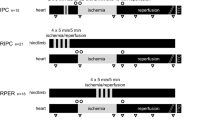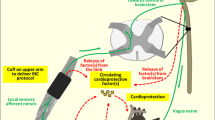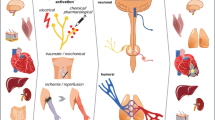Abstract
Purpose
Postconditioning confers protection to the heart after a potentially lethal episode of prolonged ischemia. There is evidence that it may also be protective when applied at a distal artery. In the present study, we sought to determine whether remote postconditioning within the heart (local) or outside the heart (distal) is effective in salvaging the ischemic heart in vivo and to compare its effect with that of the classic postconditioning.
Methods
Twenty seven open chest New Zealand white anesthetized male rabbits were divided into four groups and were exposed to 30 min regional myocardial ischemia (isc), after ligation of a prominent coronary artery, followed by 3 h reperfusion (rep) after releasing the snare. Control group (n = 7) was subjected to no additional interventions, postC group (n = 6) was subjected to four cycles of 1 min isc/1 min rep of the same coronary artery at the beginning of reperfusion, remote local postC group (n = 7) to four cycles of 1 min isc/1 min rep of another coronary artery 30 s before the end of index isc and remote distal postC group (n = 7) to four cycles of 1 min isc/1 min rep of another (carotid) artery again 30 s before the end of index isc. Infarct size (I) and area at risk (R) were delineated with the aid of TTC staining and green fluorescent microspheres respectively and their ratio was expressed in percent (%I/R).
Results
Remote local and remote distal postC reduced the % I/R ratio (17.7 ± 1.7% and 18.4 ± 1.6%, respectively vs 47.0 ± 2.5% in the control group, P < 0.01). Classic PostC had an intermediate protective effect (33.1 ± 1.7%, P < 0.05 vs all the other groups).
Conclusion
Remote postconditioning consisted of 1 min isc/1 min rep protects the ischemic rabbit heart in vivo, independently of the site of the remote artery. This intervention seems to confer a stronger protection than the classic postconditioning.



Similar content being viewed by others
References
Downey JM, Cohen MV. Reducing infarct size in the setting of acute myocardial infarction. Prog Cardiovasc Res 2006;48:363–71.
Yellon DM, Hausenloy DJ. Myocardial reperfusion injury. N Engl J Med 2007;357:1121–35.
Murry CE, Jennings RB, Reimer KA. Preconditioning with ischemia: a delay of lethal cell injury in ischemic myocardium. Circulation 1986;74:1124–36.
Zhao ZQ, Corvera JS, Halkos ME, et al. Inhibition of myocardial injury by ischemic postconditioning during reperfusion: comparison with ischemic preconditioning. Am J Physiol Heart Circ Physiol 2003;285:H579–88.
Iliodromitis EK, Cokkinos P, Zoga A, et al. Oral nicorandil recaptures the waned protection from preconditioning in vivo. Br J Pharmacol 2003;138:1101–6.
Staat P, Rioufol G, Piot C, et al. Postconditioning the human heart. Circulation 2005;112:2143–8.
Piot C, Croisille P, Staat P, et al. Effect of cyclosporine on reperfusion injury in acute myocardial infarction. N Engl J Med 2008;359:473–81.
Hausenloy DJ, Yellon DM. Preconditioning and postconditioning: new strategies for cardioprotection. Diabetes Obes Metab 2008;10:451–9.
Hausenloy DJ, Yellon DM. Remote ischaemic preconditioning: underlying mechanisms and clinical applications. Cardiovasc Res 2008;79:377–86.
Mahaffey KW, Puma JA, Barbagelata NA, et al. Adenosine as an adjunct to thrombolytic therapy for acute myocardial infarction: results of a multicenter randomized, placebo-controlled trial: the AMISTAD trial. J Am Coll Cardiol 1999;34:1711–20.
Iliodromitis EK, Paraskevaidis IA, Fountoulaki K, et al. Staccato reperfusion prevents reperfusion injury in patients undergoing coronary angioplasty: a 1-year follow-up pilot study. Atherosclerosis. 2009; doi:10.1016/j.atherosclerosis.2008.09.037.
Przyklenk K, Bauer B, Kloner RA, Whittaker P. Regional ischemic preconditioning protects remote virgin myocardium from subsequent sustained coronary occlusion. Circulation 1992;87:893–9.
Andreka G, Vertesaljai M, Szantho G, et al. Remote ischaemic postconditioning protects the heart during acute myocardial infarction in pigs. Heart 2007;93:749–52.
Li CM, Zhang XH, Ma XJ, Luo M. Limb ischemic postconditioning protects myocardium from ischemia-reperfusion injury. Scand Cardiovasc J 2006;40:312–7.
Kerendi F, Kin H, Halkos ME, et al. Remote postconditioning: brief renal ischemia and reperfusion applied before coronary artery reperfusion reduces myocardial infarct size via endogenous activation of adenosine receptors. Basic Res Cardiol 2005;100:404–12.
van Vuuren D, Genis A, Genade S, Lochner A. Postconditioning the isolated working rat heart. Cardiovasc Drugs Ther 2008;22:391–7.
Argaud L, Gateau-Roesch O, Raisky O, Loufouat J, Robert D, Ovize M. Postconditioning inhibits mitochondrial permeability transition. Circulation 2005;111:194–7.
Schmidt MR, Smerup M, Konstantinov IE, et al. Intermittent peripheral tissue ischemia during coronary ischemia reduces myocardial infarction through a KATP dependent mechanism: first demonstration of remote preconditioning.. Am J Physiol Heart Circ Physiol 2007;292:H 1883–90.
Iliodromitis EK, Miki T, Liu GS, Downey JM, Cohen MV, Kremastinos DT. The PKC activator PMA preconditions rabbit heart in the presence of the adenosine receptor blockade: is 5’-nucleotidase important? J Mol Cell Cardiol 1998;30:2201–11.
Philipp S, Yang XM, Cui L, Davies AM, Downey JM, Cohen MV. Postconditioning protects rabbit hearts through a protein kinase C-adenosine A2b receptor cascade. Cardiovasc Res 2006;70:308–14.
Cohen MV, Downey JM. Cardioprotection: spotlight on PKG. Br J Pharmacol 2007;152:833–4.
Author information
Authors and Affiliations
Corresponding author
Rights and permissions
About this article
Cite this article
Gritsopoulos, G., Iliodromitis, E.K., Zoga, A. et al. Remote Postconditioning is More Potent than Classic Postconditioning in Reducing the Infarct Size in Anesthetized Rabbits. Cardiovasc Drugs Ther 23, 193–198 (2009). https://doi.org/10.1007/s10557-009-6168-5
Published:
Issue Date:
DOI: https://doi.org/10.1007/s10557-009-6168-5




